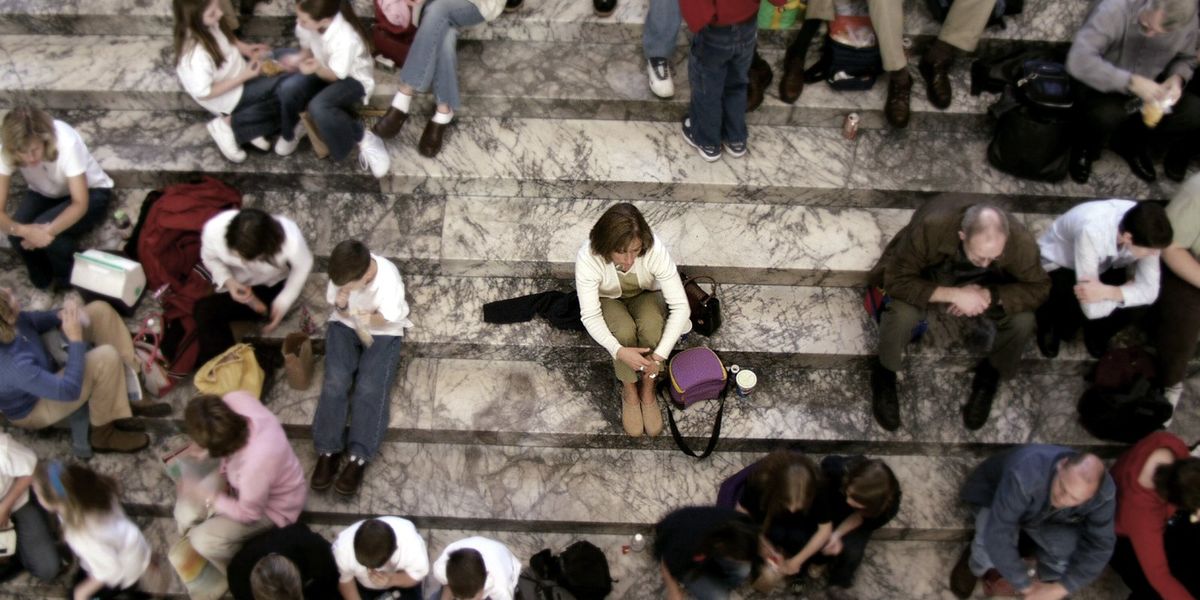When you hear the word “epidemic,” what do you think of? Smallpox? Yellow fever? Polio?
What about loneliness?
It may not seem like feeling lonely could be a serious public health issue, but that’s what makes it so sneaky — and scary. In 2023, the surgeon general called out loneliness for its severe impact on mental and physical health, comparing social disconnect to smoking 15 cigarettes a day.
And because loneliness is more subjective than, say, smoking or smallpox, recognizing and treating it can be complicated.
“If you want to know if someone is lonely, they have to tell you,” said Jeremy Nobel, M.D., MPH, founder and president of The Foundation for Art & Healing, a nonprofit that helps people find resources to combat loneliness. For perspective, Nobel said to pretend you have the universe’s most powerful telescope that can see through walls and you are on the moon. “You could see all the isolated people on planet Earth, but you couldn’t figure out who was lonely.”
Define lonely
Loneliness is the feeling of being alone, or that you don’t have meaningful, close relationships or a sense of belonging, regardless of how much social contact you have.
Ironically, there are a lot of people who feel this way. In fact, a 2024 survey by the American Psychological Association found 1 in 3 adults experience feelings of loneliness at least once a week.
And loneliness isn’t just a problem in the U.S. About 1 in 4 people worldwide — more than a billion people — feel “fairly” or “very” lonely, according to a recent survey of more than 140 countries. The survey also found that, in more than half of those countries, more women feel lonely than men.
Loneliness and mental health
Chronic loneliness is more complex than just an occasional feeling — which everyone has, by the way. It’s perfectly natural to feel lonely from time to time. But long-term, or chronic, loneliness increases your risk for certain physical and mental health conditions, including depression.
Read: Is It Just Sadness or Is It Clinical Depression? >>
Nobel said loneliness is like a pyramid. The bottom tier includes everyone because we all experience loneliness at some point. The middle tier is when you’re going through a challenge — perhaps a break-up or you’re taking care of a child or a parent with an illness — and you back away from people because you’re feeling overwhelmed. This is natural, but it leads to an increase in loneliness. The top tier is chronic loneliness.
When other people see you’re backing away, they tend to back off too, Nobel said. And the lonely person becomes even lonelier. “It leads to the very high level of loneliness — that’s where loneliness is a serious medical issue,” he said. “So the key isn’t to say, ‘Let’s never be lonely.’ The key is to avoid the spiraling from that base level to middle level to the top.”
The effects of loneliness can run deep. Research shows loneliness increases the risk for depression, anxiety, self-harm and suicide. And breaking out of the spiral gets harder over time.
Reaching out to a counselor or therapist can be an important step in managing the mental health effects of loneliness.
Psychologist Yvonne Thomas, Ph.D., said loneliness lowers self-esteem and feelings of self-worth, which can lead to changes in behavior. “It can make you start lashing out at people, and that can make others not want to be around you … and you’re creating even more loneliness because you’re chasing people away,” she said. “You don’t know you’re doing it — it’s totally subconscious.”
Thomas said loneliness can lead to other destructive patterns, such as substance overuse, sleeping too much and overeating, as a way to avoid reality. “You’re not investing in yourself or you’re not taking good care of yourself, so it can certainly cascade into other problems,” she said.
Nobel noted that women tend to take on more isolating roles, such as family caregiver, that put other people first and allow loneliness to take over.
Who is at risk of chronic loneliness?
As noted, anyone can experience loneliness, but research shows that some people are more likely to experience chronic loneliness, including people who:
- Are members of the LGBTQ+ community
- Are immigrants
- Are single parents or caregivers
- Miss out on activities because of a lack of physical ability or money
- Have long-term physical or mental health conditions
- Have poor family relationships
- Have experienced sexual or physical abuse
Signs and symptoms of loneliness
The symptoms and signs of loneliness vary from person to person but can include:
- Lacking close relationships
- Sticking to surface-level conversations and avoiding serious topics
- Feeling exhausted after spending time with others
- Feeling isolated and separated, even in a room of people
For kids and teens, parents can look for these common signs that their children may be feeling lonely:
- Poor hygiene and not caring about appearance
- A negative outlook on life
- A loss of interest in activities
- An increase in time spent alone or online
- Sadness or anxiety
Nobel, who is also the author of “Project UnLonely: Healing Our Crisis of Disconnection,” added that it can be hard for people in caregiver roles to ask for support. If you or someone you know is showing signs of loneliness, there are steps you can take to feel more connected.
How to deal with loneliness
Nobel said overcoming loneliness starts by looking inward at your interests and hobbies and what you’re passionate about. From there, he suggests you do some research to see if there’s a club or a group you can join in your area, including faith-based activities if you’re a spiritual person. “It allows you to be in a space or environment of other people who share something. Then it’s easier to disclose things about yourself, which is required in order to connect,” he said.
People who are naturally shy or introverted should take the same approach and look to connect to others through a common interest. “The key is doing something authentic — something you really get a kick out of,” Nobel said. “You can volunteer at a cat shelter, but if you don’t like cats then you’re not going to have this kind of connection through a shared passion for something.”
Many local colleges offer continuing education classes and programs that focus on activities and hobbies like dance, art, foreign language, photography, etc. If you can’t find a group near you, start your own. “It’ll give you even more passion and you’ll feel more enthusiasm again and that can help decrease those negative feelings,” Thomas said.
Read: I’m Turning Anxiety into Art >>
In addition to trying something new, Thomas said to reach out to the healthy relationships with people you have in your life. “You can tell them how you’re feeling, but listen to them too and have a true conversation,” she said. “Maybe they’re going to say they’re lonely too or they’re going through a tough time and you can help them — helping others helps a person feel less lonely.”
If existing healthy relationships are hard to come by, volunteering and fostering are other ways to add connection into your life. “You feel like you’re making a difference and you have a purpose and there is meaning again,” Thomas said.
Working on yourself is also important. Thomas recommended starting the day with 10 or 15 minutes of writing in a journal about two things: A memory where you experienced joy with other people and a time where you felt a connection with somebody. “Write it down so you remember your whole life has not been like this and it doesn’t have to stay like this,” Thomas said.
With so many people living with loneliness, the way forward is putting yourself out there and helping others do the same. “You’re not alone because 50% of people feel significantly lonely from time to time,” Nobel said. “And the other half may not just be willing to say it.”
This educational resource was created with support from Pfizer, a HealthyWomen Corporate Advisory Council member.
Related Articles Around the Web
Publisher: Source link







